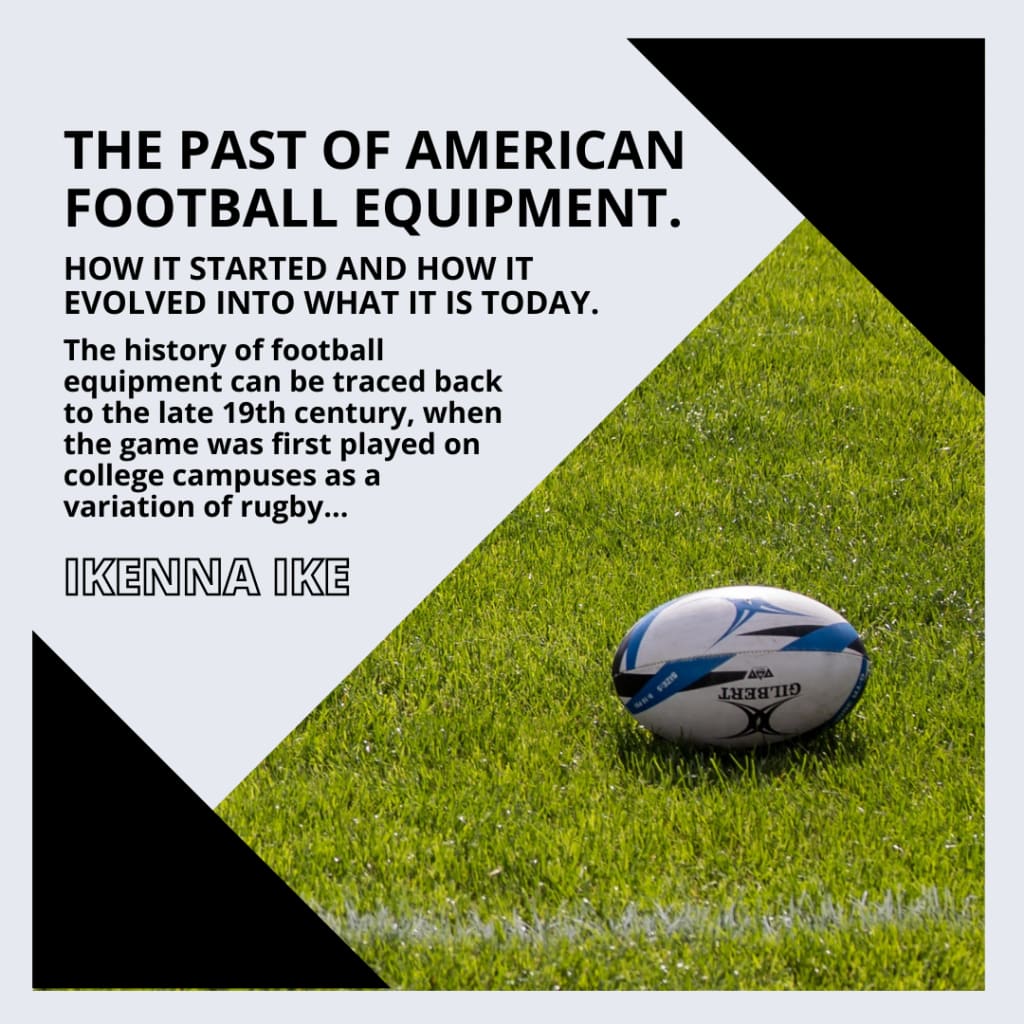Ikenna Ike- The past of American football equipment.
How it started and how it evolved into what it is today.

The history of football equipment can be traced back to the late 19th century, when the game was first played on college campuses as a variation of rugby. The equipment that players used back then was very different from what they use today, and some of it can be considered as antique or vintage.
The first helmets were made of soft leather and were called “head harnesses”. They were worn by some players as early as the 1890s, but they were not mandatory until 1939. The first helmets had no face masks or ear holes, and they offered little cushioning or ventilation.
In the 1930s, hard plastic and foam replaced the leather, and the first face masks and ear holes were added. In the 1950s, the single-bar face mask was popularized. In the 1960s, the web-like interior of the helmet was replaced by foam cells, and some helmets used air valves to create a custom fit. In the 1970s, the full-face mask became the standard, and the helmet shape became more streamlined and aerodynamic. In the 1980s, the polycarbonate shell and the polyurethane cap were introduced, providing more durability and protection. In the 1990s, the helmet design became more varied and colorful, as teams and players customized their helmets with logos, decals, and stripes. In the 2000s, the helmet incorporated new features such as wireless communication, sensors, and visors. Today, the helmet is a sophisticated piece in constant testing and improvement to prevent and reduce head injuries.
The first shoulder pads were made of leather and were worn by some players in the late 19th century, but they were not widely used until the 1950s. The first shoulder pads were bulky and heavy, and they restricted the movement and vision of the players. They also caused overheating and sweating, as they had no ventilation or cooling system. Some of the oldest shoulder pads can be found in museums or collections, such as the ones worn by Red Grange.
In the 1960s, hard plastic and foam replaced the leather, and the shoulder pads became lighter and more flexible. In the 1970s, the shoulder pads became more anatomical and ergonomic, and they were fitted with straps and buckles to adjust the size and position. In the 1980s, the shoulder pads became more modular and customizable; they were equipped with back plates, neck rolls, and rib protectors. In the 1990s, the shoulder pads became more sleek and stylish, and they were decorated with team colors and logos. In the 2000s, the shoulder pads incorporated new features such as temperature management, shock absorption, and impact detection. Today, the shoulder pads are a complex piece of equipment that is designed to optimize the performance and safety of the players.
The pants were originally made of tough canvas material, with light padding sewn into the thigh and knee area. They were also designed with interior pockets to hold the pads in place. The pants changed little until the 1960s, when nylon materials replaced the canvas, and the pants became more comfortable and breathable. The pants also became more colorful and fashionable, as teams and players added stripes, patterns, and logos to their pants.
The cleats were originally made of leather, with metal spikes attached to the sole. They were also very heavy and stiff, and they caused blisters and injuries to the feet. The cleats changed significantly in the 1970s, when synthetic materials replaced the leather, and the spikes became more flexible and detachable. The cleats also became more specialized and functional, as different types of cleats were developed for different positions and playing surfaces.
The gloves were originally made of leather, with no padding or grip. They were worn by some players to protect their hands from cold and abrasion, but they were not very effective or comfortable. The gloves improved dramatically in the 1980s, when rubber and latex materials replaced the leather, and the gloves became more padded and sticky. The gloves also became more diverse and versatile, as different types of gloves were created for different positions and weather conditions.
The mouth guard was originally made of rubber, with no shape or fit. It was worn by some players to protect their teeth and gums from damage, but it was not very comfortable or hygienic. The mouth guard improved considerably in the 1990s, when thermoplastic and gel materials replaced the rubber, and the mouth guard became more moldable and customizable. The mouth guard also became more advanced and innovative, as some mouth guards were integrated with sensors, microphones, and cameras.
The equipment that players will use in the future will be even more different, as new materials and technologies will be introduced. The equipment that players use is not only a means of protection, but also a symbol of identity, culture, and style.
About the Creator
Ikenna Ike
Hello, I am a fun person and I like to write about various topics that I am passionate about, such as sports such as basketball, American football, and other topics such as music or news.






Comments
There are no comments for this story
Be the first to respond and start the conversation.